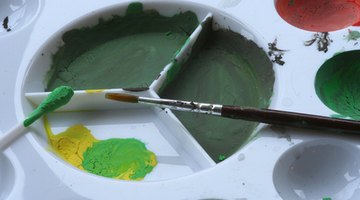How to Paint Vine Leaves & Flowers
Vines, leaves and flowers add a detailed, finished look to your decor. Wine cellars, garden rooms and mailboxes offer great opportunities to use this simple decorating trick. Before you start, flip through garden magazines to familiarize yourself with the shapes of leaves and vines. Consider your color scheme.

Things You Will Need
- No. 10 round paintbrush
- 1-inch flat paintbrush
- Palette
- Rag
- For walls and ceilings:
- Acrylic artist paints
- Jar of water
- For mailboxes:
- Artist oil paints or enamels
- Jar of turpentine
- For exterior projects:
- Spray-on or brush-on clear sealant
If indoors, hold paint chips next to your walls and furniture to find good combinations. Choose at least two compatible colors for each element of your artwork. For instance, if you decide on yellow flowers, use both cadmium and lemon yellows. For a more dramatic look, pair colors with their opposites such as yellow and violet. The materials you'll need depend on your surface.
Basic Vines and Flowers
-
Ensure that your painting surface is clean and dry. For walls and ceilings, interior latex paint acts as a primer. For mailboxes and other metal surfaces, use a spray-on primer in a well-ventilated area.
-
Prepare your palette by squeezing a small amount of each paint color onto it, about the size of a dime. This leaves you room for mixing colors and prevents wasting paint. If you have a large project, you can always add more as you run out.
-
Start with the vines. Wet the round brush. Remove excess water. Load the paintbrush with at least two types of green. Do not mix. Test the brush on your palette to ensure the paint flows smoothly without dripping. Add or remove water to the paint as needed. When you are ready, hold the brush loosely and create a wobbly, twisty line for your vine.
-
Change to the flat brush for the leaves. Prepare as with the round brush until you get an acceptable proportion of water to paint. Remember to use at least two types of green. Lay the brush flat next to the vine and make a short, curved stroke away from it. This creates one side of the leaf. Flip the brush over. Start at the place and curve the brush in the other direction to make the opposite side of the leaf.
-
Clean out your flat brush and load it with at least two flower colors. Start at the center of the flower. Lay the brush flat and make a short, curved stroke outward. Do this for each petal.
-
Seal your outdoor art. For small objects, like mailboxes, use several coats of a clear, spray-on sealant. For larger surfaces, two coats of a brush-on sealant work better. If you want maximum color protection, use an ultra-violet protective sealant.

Tip
Practice on a sheet of paper until you get the look you want. Vines and leaves don't have to be green. Try blue and white, sienna and blue or yellow and white. You can also mix any of these colors with green to get a more subtle effect. For an old world look, glaze your work with a thin layer of burnt umber. Prepare the glaze by mixing burnt umber and glaze medium or water. For use over oils or enamels, mix burnt umber with linseed oil.
Warning
Always use turpentine and spray sealants in a well-ventilated area to avoid headaches and respiratory irritation.
Pay careful attention to the lengthy drying times for oil paints and enamels.
Resources
Tips
- Practice on a sheet of paper until you get the look you want.
- Vines and leaves don't have to be green. Try blue and white, sienna and blue or yellow and white. You can also mix any of these colors with green to get a more subtle effect.
- For an old world look, glaze your work with a thin layer of burnt umber. Prepare the glaze by mixing burnt umber and glaze medium or water. For use over oils or enamels, mix burnt umber with linseed oil.
Warnings
- Always use turpentine and spray sealants in a well-ventilated area to avoid headaches and respiratory irritation.
- Pay careful attention to the lengthy drying times for oil paints and enamels.
Writer Bio
Bethany DuVall dances among three loves: writing, painting and teaching. She graduated from New College with a humanities degree. National anthologies like "Remembrances" began publishing her work in 1995. DuVall's articles about arts and education appear in local publications such as "Art Thou" and on various websites.
Photo Credits
- paint brushes image by Horticulture from Fotolia.com
- paint brushes image by Horticulture from Fotolia.com
- palette colorée image by Francis Lempérière from Fotolia.com
More Articles



